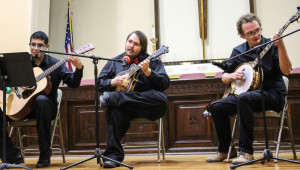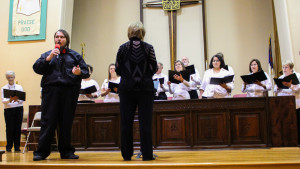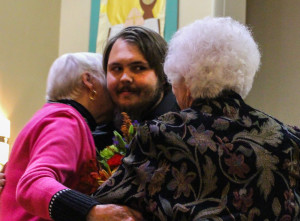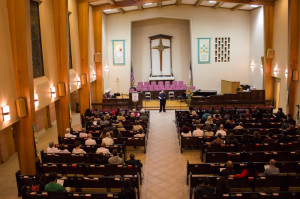Tags
Related Posts
Share This
Church at Church
John Church presented his senior show at St. John’s United Methodist Church on Nov. 6. Under the high-beamed ceiling, overlooked by stained-glass effigies, students and staff from nearly every department of SFUAD filled the padded, wooden pews. Church’s show, which serves as his senior thesis, included pieces from numerous musical periods, ranging from the middle ages to the 1950s. “I tried to represent the styles of music I have spent the most time with both as a student and as a performer,” Church said.
Church’s trademark humor was ever-present throughout the evening. At the beginning of the show he asked for the crowd’s attention, then told them they could go back to talking. He also added an irreverent “Shave and a Haircut” piano tag after a Bach Fugue. “If I did that at a conservatory, I would have had a few points knocked off of my performance,” he said. But this wasn’t a conservatory performance; it was a SFUAD performance. So when Church produced his signature instrument, the mandolin, to christen the start of the Baroque section, he felt free to ask the audience to “say hello to my little friend.”
Church constructed the program with the intention of keeping the show uplifting. Every CMP student is required to stage a musical performance their senior year. Some of these concerts lean toward the simplistic, with only one or two performers, while others present on a grander scale. Church’s show was one of the latter. He selected fellow musicians to accompany him based on the relationships he has formed during the last 3 1/2 years at SFUAD.

Maggie Johnson, Tawanda Suessbrich-Joaquim, Parker Orr, John Church, Judson Seeley and Saqeef Ali singing at John Church’s senior show. Photo by Christy Marshall
For the Renaissance period, Church gathered a group of vocalists to sing four choral pieces. Even during rehearsals at school, these pieces inspired tears. Chills accompanied the tears when the choir’s combined voices ascended through the open air of St. John’s worship space. “I looked out and people had their eyes closed,” said choir member and CMP major Janel Blanco. “They were all just feeling the movement of the choir.”
The choir sang two motets by Giovanni da Palestrina, compositions that juxtapose several independent melodies, harmonizing in what is known as a polyphonic style. Fellow CMP students Elise Stoffer, Tawanda Suessbrich-Joaquim, Maggie Johnson, Judson Seeley, Saqeef Ali and Parker Orr, joined Church and Blanco for the Palestrina motets. Claudio Monteverdi’s “Messa a Quattro voci: Kyrie” followed the Palestrina pieces. Church’s mother, Ann Church, who sat in the front row, said, “John and I have shared a love of Palestrina and Monteverdi for years.”
Many members of Church’s family were also in attendance. His brother, David Church, handled the cinematography for the evening. David, who studies Film at SFUAD, said his brother did not really become serious about music until the family moved to New Zealand in 2008. Previously David and John had both taken piano lessons, but neither of them stayed committed. “It was like pulling teeth to get them to practice,” said John’s father, Todd Church. “Four or five years later, John said he wanted to learn how to play.” Though he and his wife were skeptical, he says that once John got started again, they couldn’t get him to stop.”
John displayed his piano skills in his performance of two widely varying styles, first in Preludes and Fugues by Johann Sebastian Bach and then, following an intermission, in ragtime pieces by Scott Joplin. The Bach pieces wrapped up the Baroque section of the evening with two selections from the composer’s famous Well-Tempered Clavier. These solo keyboard pieces feature contrapuntal melodies, separate musical phrases that occur at the same time. The themes repeated and ascended to higher pitches at a rapid pace. John attacked the keys of the piano for “Prelude in C minor.” The separate musical themes pushed against each other, rising and falling. It sounded as if the piano was losing its mind.
John also played the Prelude to Bach’s “Cello Suite No. 1 in G Major” on his mandolin. He previously debuted his rendition of the suite at the Santa Fe Community Orchestra’s celebration of Bach’s 330th birthday in March. Though his performance that day was impressive, it was obvious on the night of his senior show that John had been practicing the piece for months. He nailed the arpeggios, hammering down on the frets, plunking the strings with the incessant rhythm of a clock.
Antonio Vivaldi’s “Concerto in A minor” from the larger work, L’Estro Armonico, was sandwiched between the Bach Preludes. John continued on mandolin and was joined by SFUAD Teacher of Piano and Composition Melanie Monsour on piano. They performed the first movement of the Concerto, which rushed along with great intensity. Both instruments played a similar melody, reinforcing the notes, reaching octaves to assault the ears. John’s pick struck the mandolin’s body as he plucked sixteenth notes and the musicians finished in a strong, unified retard.
John said he would have liked to add more music to both halves of the show – including pieces that were written after Bach’s time – but the show was already too long, and doing so would have necessitated adding a third set. In the end, he had to choose the music that meant the most to him and illustrated his eclectic taste.

Eric Cureno on guitar, John Church on mandolin and Sam Armstrong-Zickefoose on banjo. Photo by Christy Marshall
The audience got to see just how eclectic his taste is when the second half of the performance began. “The music’s all been pretty old so far,” John said. “Now we get to the rich tradition of Americana.” Sam Armstrong-Zickefoose and Eric Cureno joined John on banjo on guitar for the bluegrass portion of the show. The set opened with the Beatles classic, “I’ve Just Seen A Face.”
While living in New Zealand, John attended a concert medley of music by the world’s greatest composers, starting with Bach and moving forward. “I kept thinking, ‘they left out Lennon and McCartney,’” he said. “Their music transcends the pop genre.” He said he chose this particular Beatles song because it was one he used to sing with his mother, and it translated well to bluegrass.
John muted his mandolin strings, strumming the tempo before leaping into the song. Armstrong-Zickefoose plucked incessantly at his banjo, but kept the instrument subdued. Cureno traded solos with John during the song’s break. While the song lacked the familiar Beatles harmonies, it was still a showstopper with John singing the lyrics. Armstrong-Zickefoose, who has his own senior show on Nov. 14, said he was pleased with the performance, even though the trio did not get a lot of practice. “I was trying to be aware of not stepping on John’s toes. It takes time to get comfortable with each other and it’s different every time you play.”
They followed up the Lennon and McCartney song with the traditional bluegrass song, “Arkansas Traveler” by Colonel Sandy Faulkner, and the solemn “Learning How to Die” by Jon Foreman. “His was the first music that struck me on a poetic level,” John said of Foreman. “That was the first factor that led me to want to play music.” The only mellow portion of the evening, the song professes the idea that while we try to improve ourselves in life, we are ultimately slowly breaking down. “All along thought I was learning how to take,” John sang, “but really I’ve been learning how to die.”

John Church, Wendy Russell and the St. John’s United Methodist Church Chancel Choir. Photo by Christy Marshall
Saint John’s United Methodist Church Chancel Choir joined John on stage for the finale. Church has worked closely with the choir in his internship at St. John’s. The choir’s director, Wendy Russell, spoke highly of John. “He’s doing a bluegrass band here,” Russell said. “Anyone can walk in with an instrument and John will orchestrate it.”
John and Russell moved the piano aside and the choir took its place for Hall Johnson’s “Ain’t Got Time to Die.” The rousing number featured John singing lead vocals, adopting a deep, spiritual baritone. At the end of the number, the audience immediately jumped to its feet in applause. The echo of slapping hands struck the balcony balustrades.
John’s grandmothers, Betty Church and Marlene Kostal, handed John a bouquet. Betty traveled from Wisconsin and Kostal came from South Dakota to hear John play. “John was always so willing to perform,” Betty said. “He can play anything. He’s grown a lot since he’s been at this school.” Kostal pulled a wet hanky from her purse. “He wrote his first song when he was three years old,” she said. “It was about an electrician.”
Rounding out the family reunion was John’s uncle, Tom Church, who flew in from Minnesota to attend the show. “John and I have been talking about music since he was a kid,” he said. Tom is a musician himself, specializing in saxophone and harmonica. “We jam when we get a chance. I knew he had chops way back when, but lately, the way he can focus on a tune is downright scary. I’ll play in his band anytime.” Tom obviously had a great impact on John, who gave special thanks to his uncle in the show’s program.
Asked of his opinion on the performance, John said he was more pleased than he usually is with shows he has put together. “I was less focused on what I didn’t do right,” he said, though he felt the evening’s first song could have been better. “That’s where most of my nervous energy went.” The a cappella piece, “Salve Regina,” sung in Latin by John alone, was one of the night’s most moving moments. If this was his weakest song, it was, as John said of his impending music career, “all uphill” from there.
At the end of the show, John reminded the audience that “you don’t stop being a student just because you get out of school.” He thanked his family, friends, teachers and the musicians for making him sound good. John then added, “or making us sound good. I love you all.” Judging by the hugs and smiles shared after the performance, the feeling was mutual.










 Jackalope Magazine is the student magazine of Santa Fe University of Art and Design. Building on the interdisciplinary nature of our education, we aim to showcase the talent of our university and character of our city.
Jackalope Magazine is the student magazine of Santa Fe University of Art and Design. Building on the interdisciplinary nature of our education, we aim to showcase the talent of our university and character of our city.
Congratulations John for doing so well!! Larry and I would love to hear you sing and play sometime!! And congratulations Todd and Ann, you did a wonderful job raising both your boys!!